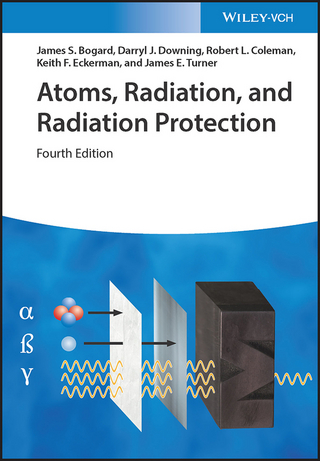
Terrestrial Space Radiation and Its Biological Effects
Kluwer Academic/Plenum Publishers (Verlag)
978-0-306-43020-6 (ISBN)
Radiation Environment in Space.- The Earth’s Trapped and Transient Space Radiation Environment.- Ambient Electron Density Distribution at About 500 km Altitude at the Earth’s Ionosphere.- The Space Radiation Environment at 840 km.- Solar Proton Event Forecasts.- Radiation Hazards in Low Earth Orbit, Polar Orbit, Geosynchronous Orbit, and Deep Space.- Analysis of the Radiative Risk During Hermes Mission.- Biological Effects of Space Radiation.- Heavy Ion Effects.- Heavy Ion Effects on Cells: An Approach to Theoretical Understanding.- Cosmic Ray HZE Particle Effects in Biological Systems: Results of Experiments in Space.- Effects of Low and High LET Radiation on Neoplastic Transformation in Cells and the Importance of Single Track Effects in Space.- Effects of LET, Fluence and Particle Energy on Inactivation, Chromosomal Aberrations and DNA Strand Breaks.- Induction of Chromosome Aberrations in Chinese Hamster Cells After Heavy Ion Irradiation.- Heavy Ion Radiation Effects on Single Spores of Bacillus Subtilis.- Biological Action of Heavy Ion Irradiation on Individual Yeast Cells.- Delta-Electron Emission in Heavy Ion Collisions.- Genetic Effects.- The Role of Repair Processes in Cellular and Genetical Response to Radiation.- Reactions of Genetic Systems to Heavy Ions: Acute and Late Effects.- Nature of Radiation Induced Mutations. Experimental Approaches on the Question of Intragenic Events.- Genetic and Developmental Responses of Radiation Sensitive Mutants of the Nematode, C. elegans, to Ultraviolet, High and Low LET Radiation.- Ionizing Radiation Induced Mutagenesis: Molecular Genetic Changes and Role of DNA Lesions and Repair.- Cellular Effects.- Radiation Physics Related to Biology.- Biochemistry of Subcellular and Cellular Radiation Effects.- High Energy ProtonInduced Mutations in Cultured Chinese Hamster Cells.- Cultures of Erythroleukemic Cells (K-562) on a Stratospheric Balloon Flight.- Transposition of Retrotransposons After Gamma and UV Irradiation.- Flow Cytometry Techniques for the Study of Irradiated Hematopoietic Stem Cells.- The Kinetics of UV-Induced Thymine Dimerization.- Effects of Ultrahigh Vacuum and UV Irradiation on Transforming DNA of Haemophilus Influenzae.- Effect of High-Vacuum, Deep Temperatures and VUV Irradiation on Bacterial Spores.- Physiology Radiobiology.- Selected Examples of Degenerative Late Effects Caused by Particulate Radiations in Normal Tissues.- Delayed Effects of Proton Irradiation in the Lens and Integument: A Primate Model.- Life Shortening and Causes of Death in Experimental Animals Following Whole-Body Exposure to Ionizing Radiation.- Acute Radiation Syndromes in Man.- Extrapolation of Animal Data to Man.- Radiation Induced Damage to the Regenerative Capacity of Surgically Traumatized Rat Femur After Single Doses of X-Rays.- Cardiopulmonary Effects Following Local Irradiation of the Heart in Adult Male Wistar/Neuherberg Rats.- Post-Irradiation Alterations in Cerebral Blood Flow.- Analysis of the Involvement of the Terrestrial Space Radiation in the Microgravity Effects on DrosophilaMelanogaster Development and Aging.- Behavioral and Neurobiological Aspects.- Current Trends in Behavioral Radiobiology.- Effects of Iron Particles on Behavior and Brain Function: Initial Studies.- Correlative Motor Behavioral and Striatal Dopaminergic Alterations Induced by 56Fe Radiation.- Protection From Space Radiation.- Variation of Galactic Cosmic Radiation by Solar Modulation, Geomagnetic Shielding and Shielding by Material.- Radiation Problems in Manned Spaceflight — European Efforts.- SpaceRadiation Exposures for Manned Polar Missions: A Parametric Study.- Protection of Polar Platforms from Penetrating Radiation.- Galactic Cosmic Radiation Doses to Astronauts Outside the Magnetosphere.- DNA and Radioprotection.- Excision Repair is Enhanced by WR-2721 Radioprotection.- Impact of Spaceflight Environment on Radiation Response.- Radiation Protection Guidelines for Space Missions.- Dosimetry.- Space Radiation Dosimetry on U.S. and Soviet Manned Missions.- Measurements of Cosmic Ray LET-Spectra for the D1 Mission Using Plastic Nuclear Track Detectors.- Cosmic Ray LET-Spectrum Measured in the Spacelab 2 Mission.- New Directions in Space Dosimetry.- Summary.- Participants.
| Erscheint lt. Verlag | 11.3.1989 |
|---|---|
| Reihe/Serie | Nato Science Series: A ; 154 |
| Zusatzinfo | X, 864 p. |
| Verlagsort | New York |
| Sprache | englisch |
| Maße | 155 x 235 mm |
| Themenwelt | Naturwissenschaften ► Biologie |
| Naturwissenschaften ► Physik / Astronomie ► Angewandte Physik | |
| ISBN-10 | 0-306-43020-7 / 0306430207 |
| ISBN-13 | 978-0-306-43020-6 / 9780306430206 |
| Zustand | Neuware |
| Haben Sie eine Frage zum Produkt? |
aus dem Bereich


